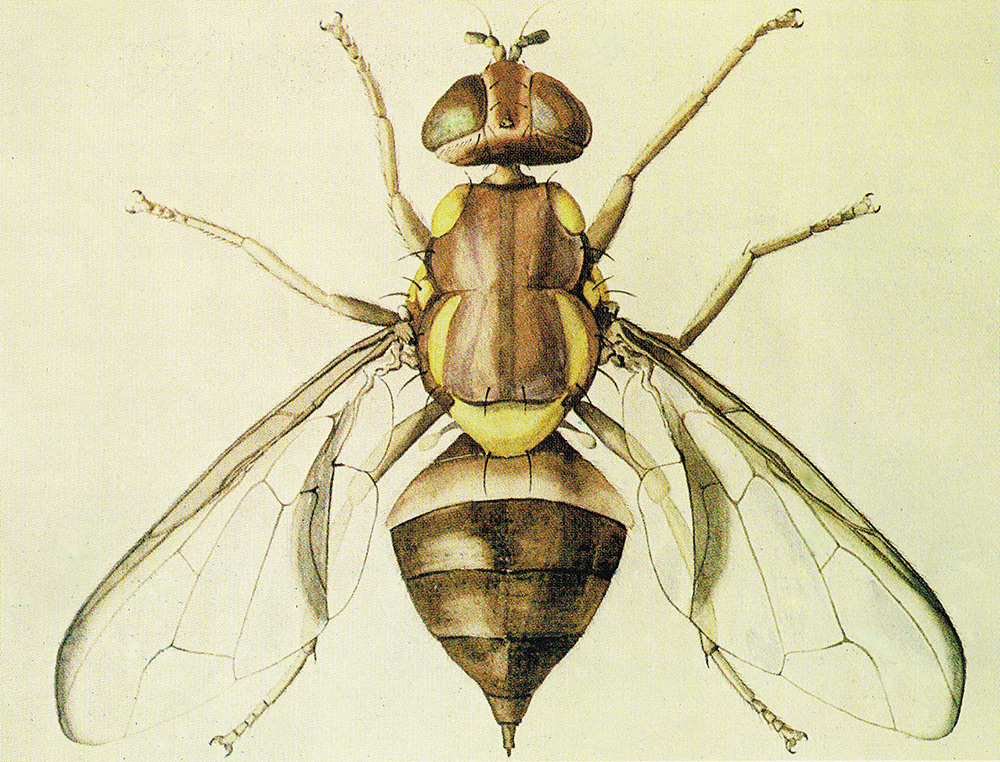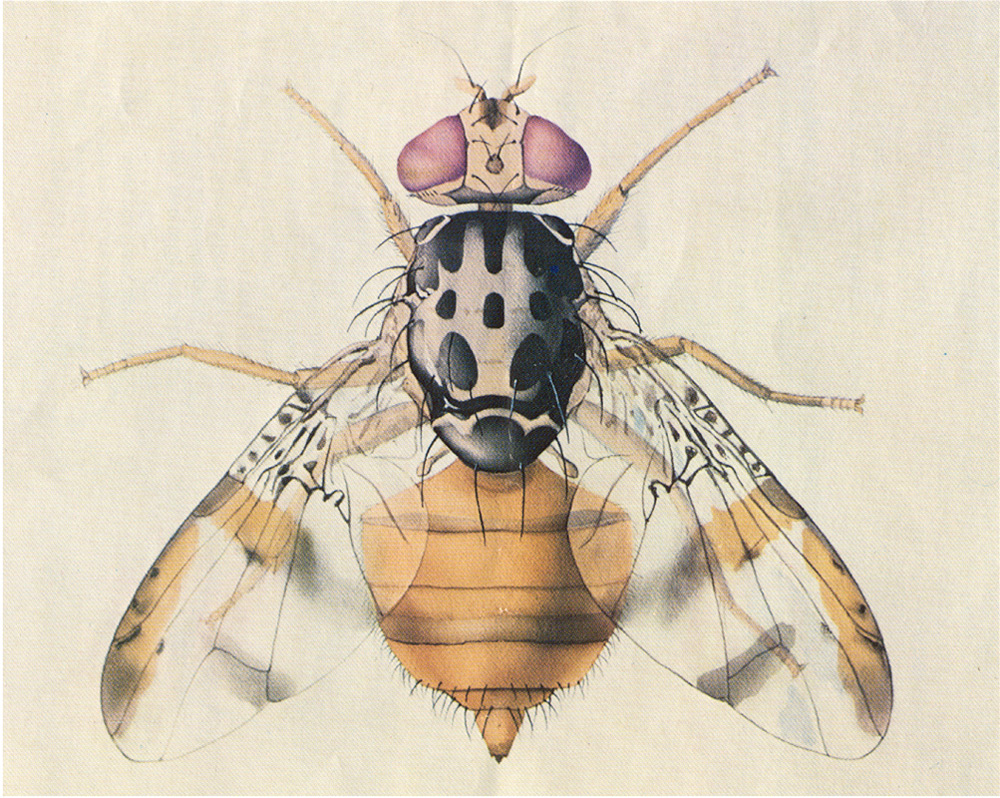Fruit flies are categorised as both exotic and endemic biosecurity threats to Australia and are one of the world’s most destructive horticultural pests (Farm Biosecurity, 2016).
Exotic fruit flies were ranked as the number three plant pest in 2016 (Department of Agriculture and Water Resources, 2016a) with the greatest potential cost and impact to the Australian horticulture industry. The presence of some species of exotic fruit fly could reduce the capacity to trade in domestic and international horticultural markets with an average annual value of $4.8 billion (National Fruit Fly Implementation Committee, 2010).
Fruit fly spread
More than 300 types of fruit and vegetables can carry the flies, eggs or pupae (Farm Biosecurity, 2016). While Australia already has some types of fruit fly pests, we are free from some of the more damaging ones. They can be blown in by monsoon winds or arrive on imported fruit or plant material. Once here, the flies could spread quickly through the movement of infested products.
The threat is very real. Some of these flies are regularly found on islands of the Torres Strait during the wet season. But they are eradicated before they get a chance to move south and into production areas on the mainland (Farm Biosecurity, 2016). In 1995 the detection of oriental fruit fly (then called papaya fruit fly) threatened fruit crops around Cairns and cost $33.5 million to eradicate. If another outbreak occurred in northern Australia, restrictions would likely be placed on the sale of fruit from the infested region to other states and territories, or overseas (Department of Agriculture and Water Resources, 2016b).
Management
Australia has an integrated national approach to protect horticulture from fruit fly incursions to maintain and enhance market access. Managing fruit fly involves dealing with species already present such as the Queensland fruit fly and Mediterranean fruit fly, and using surveillance to detect any exotic fruit fly (National Fruit Fly Implementation Committee, 2010).
Australia continues to invest in fruit fly research and in fact South Australia has taken the lead in scientifically combating Queensland fruit fly and helping protect the nation’s horticultural production. A $3.8 million National Sterile Insect Technology (SIT) facility has been constructed in Port Augusta to assist in the fight against fruit fly – a first for Australia. Once fully operational it will produce 50 million sterile male Queensland fruit flies each week. The flies will be released to mate with wild females, collapsing wild populations in fruit fly affected horticulture growing regions across Australia and New Zealand (PIRSA, 2016a).
Endemic fruit flies are a priority viticulture pest (Plant Health Australia, 2013). Two species of major concern to commercial fruit growers (Plant Health Australia, 2016) are:
Queensland fruit fly (Bactrocera tryoni)
- Adult flies are about 7mm long and are reddish-brown in colour, with distinct yellow markings. Many people confuse vinegar flies with QFF. Vinegar flies are much smaller insects and will not damage home-grown produce.
- Larvae (maggots) are about 5-10mm long and creamy-white in colour.
- Native to north-eastern Australia.
- Occurs in parts of Queensland, New South Wales, Victoria and the Northern Territory.
- Most active from September through to May but can also be active in warmer periods during the winter months.

Mediterranean fruit fly (Ceratitis capitata)
- Adult flies are about 3-5mm long, with a light brown body and mottled wings.
- Larvae (maggots) grow to about 8mm long and are white in colour.
- Species is restricted to Western Australia.
- Most active from October through to May.

Fruit Fly Management in South Australia
Importance of remaining fruit fly free
South Australia and the SA Riverland are recognised as being free of both Queensland Fruit Fly and Mediterranean Fruit Fly. South Australia remains the only Australian mainland state that is fruit fly free. Area freedom means significant advantages for South Australia’s $1.15 billion horticultural sector and for the community. Produce grown in a pest free area is accepted by many markets without pre or post-harvest treatment. Cost of production is thereby reduced, insecticide residue problems are avoided and the marketability of the product is frequently improved (PIRSA, 2015a).
Every year the South Australian Government spends about $5 million keeping fruit fly and other plant pests out of the state, through a range of prevention, surveillance and eradication measures (PIRSA, 2016b).
To maintain pest free status, Biosecurity SA in conjunction with growers, runs an integrated program comprising the following:
- Monitoring via a state-wide trapping grid.
- Border controls – quarantine stations, disposal bins.
- Public awareness/education – media, signage.
- Movement controls/conditions of entry – Interstate Certification Assurances (ICA) & Compliance Arrangements (CA), random roadblocks and eradication of isolated detections.
- Response – eradication of isolated detections
What happens in South Australia in an outbreak situation of an endemic fruit fly?
If an outbreak is declared, a formal eradication program begins, which typically consists of:
- A public awareness campaign, establishment of quarantine areas and movement restrictions.
- A hygiene component to remove fallen host fruit and check for larvae.
- A baiting component where organic bait is applied to trees throughout the outbreak area to attract and kill flies.
- A trapping component where a concentrated trapping grid is established to delimit the incursion and to monitor fruit fly numbers.
- A sterile release component where large numbers of sterile fruit fly may be released to eliminate any remaining wild population.
What does this mean for winegrape movement for South Australian growers?
When a fruit fly outbreak has been declared in South Australia, restrictions are placed on the movement of winegrapes within the outbreak area. Restrictions are maintained for a minimum of 12 weeks, or one generation plus 28 days (whichever is the longest period) after the last detection of a fruit fly in a fruit fly trap or larvae in fruit (PIRSA , 2015b). Vinehealth Australia works with Biosecurity SA, by overlaying the declared quarantine zones on a vineyard map layer and notifies growers of fruit movement requirements.
For those carting grapes into and out of a fruit fly outbreak zone, there are some simple general requirements that must be complied with to assist containment:
- Grapes must be consigned to prevent spillage (filled to below 200mm from the top edge of the bin) or covered, and processed at a winery within 24 hours of arrival.
- If winegrapes are to be processed outside of the state, they must be consigned under Interstate Certification Assurance (ICA-33) Movement of Winegrapes. Note – no winegrapes must be moved through or to Western Australia.
- Consignments may have to be accompanied by a certificate from the Outbreak Control Centre.
At the time of a fruit fly outbreak, Vinehealth Australia will work with Biosecurity SA to disseminate communications to affected parties, including carriers, wineries and grape growers outlining exact movement requirements.
References
- Department of Agriculture and Water Resources (2016a). https://www.agriculture.gov.au/pests-diseases-weeds/plant
- Department of Agriculture and Water Resources (2016b). https://www.agriculture.gov.au/biosecurity/australia/naqs/naqs-target-lists/fruit-flies
- Farm biosecurity (2016). https://www.farmbiosecurity.com.au/top-40-priority-pests-named-and-shamed/
- National Fruit Fly Implementation Committee (2010). National Fruit Fly Strategy – Implementation Action Plan. Plant Health Australia.
- PIRSA (2015a). Fruit Fly Management Factsheet – South Australia v4.0 https://www.pir.sa.gov.au/__data/assets/pdf_file/0006/258693/Fruit_Fly_Management_Fact_Sheet_V4.pdf
- PIRSA (2015b). Winegrape growers fruit fly information. https://www.pir.sa.gov.au/biosecurity/fruit_fly/fruit_fly_outbreaks/wine_grape_growers_fruit_fly_information
- PIRSA (2016a). Fruit Fly. Biosecurity SA. https://www.pir.sa.gov.au/biosecurity/fruit_fly
- PIRSA (2016b). Sterile Insect technology factsheet. https://www.pir.sa.gov.au/__data/assets/pdf_file/0016/232261/Sterile_Insect_Technology_A4_CJ.pdf
- Plant Health Australia (2016). https://preventfruitfly.com.au/gardeners/about-fruit-fly/species/
- Plant Health Australia (2013). Biosecurity Manual for the Viticulture Industry v1.0. https://www.farmbiosecurity.com.au/wp-content/uploads/2014/07/Biosecurity-Manual-for-Viticulture-Industry.pdf